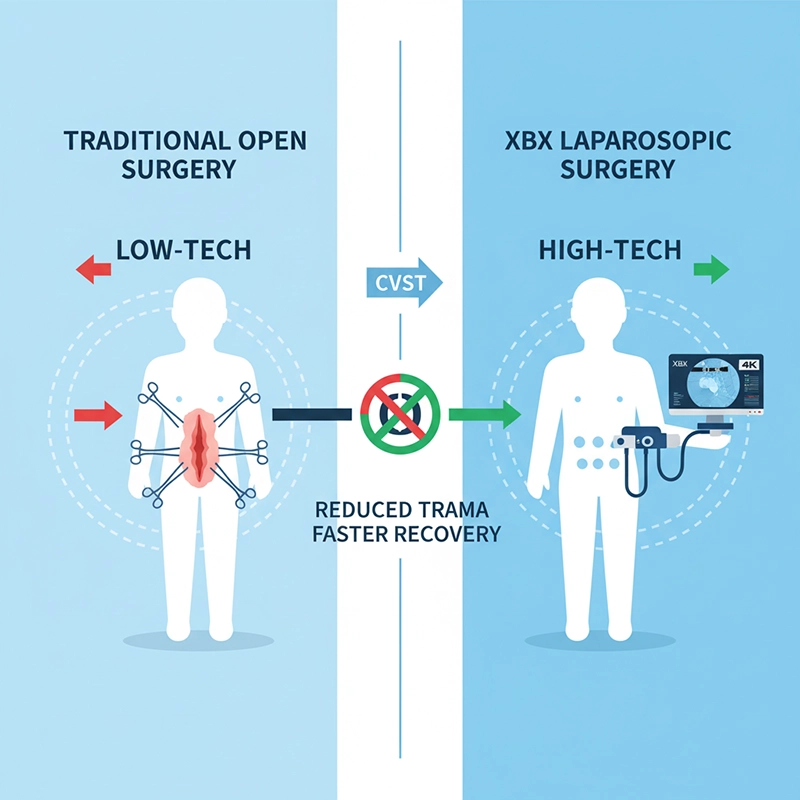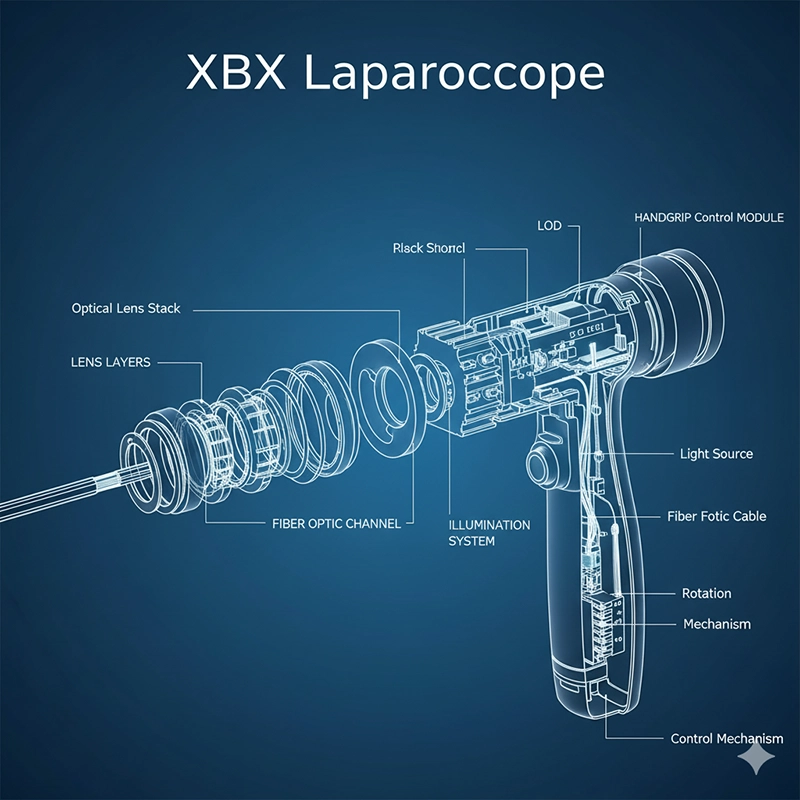Table of Contents
The XBX Laparoscope minimizes surgical trauma by allowing surgeons to operate through small incisions while maintaining a full, high-definition view of the abdominal cavity. Its precision optics, steady illumination, and ergonomic control help reduce bleeding, tissue damage, and recovery time compared to traditional open surgery. In essence, the XBX Laparoscope combines advanced imaging with minimally invasive technique to make abdominal operations safer, faster, and less painful for patients.
Not long ago, abdominal surgery meant long scars, days in the hospital, and weeks of recovery. So yes, it’s hard to imagine how far surgery has come in just a few decades. The difference lies in technology—what was once a large incision has become a keyhole entry point, and what was once guided by feel is now directed by crystal-clear vision. The XBX Laparoscope stands at the center of this transformation, proving that precision optics can change not only procedures, but outcomes and patient confidence.
In the past, surgeons had to cut wide and deep to access abdominal organs. While effective, this approach caused unnecessary trauma and risk. The laparoscope changed that paradigm entirely. By providing real-time imaging inside the abdomen through a small entry point, doctors can now perform complex operations without large incisions. The XBX Laparoscope builds upon this foundation with sharper optics, improved light balance, and ergonomic design tailored to modern surgical workflows.
Introduction of fiber-optic illumination in early scopes improved brightness.
Miniaturization of lens systems made insertion less invasive.
Integration of HD video sensors allowed clear, color-accurate views.
XBX technology added real-time stabilization and fluid control for better precision.
Each advancement didn’t just refine an instrument—it redefined surgical expectations. With the XBX Laparoscope, minimal access no longer means limited vision; it means targeted accuracy and faster healing.
The XBX Laparoscope achieves minimal trauma through a balance of optical clarity and precision mechanics. Its lens transmits HD imagery from inside the body to a monitor, giving surgeons a magnified, well-lit field without cutting large areas of tissue. The fine, calibrated insertion tube ensures that instruments glide smoothly, reducing mechanical stress and accidental tissue friction.
Micro-incision access: Entry points as small as 5 mm replace traditional 15–20 cm cuts.
Stable imaging: Anti-shake optical sensors prevent disorientation during delicate dissections.
Controlled lighting: Adaptive illumination reduces glare and prevents tissue overheating.
Ergonomic control: Balanced handle and rotation ring help surgeons move smoothly and accurately.
In simple terms, less movement inside means less damage. That’s how the XBX Laparoscope reduces postoperative pain, minimizes bleeding, and helps tissues recover naturally without unnecessary stress.
Let’s look at the contrast. In an open cholecystectomy (gallbladder removal), the surgeon makes a large abdominal incision and uses retractors to access the organ. In a laparoscopic procedure using the XBX Laparoscope, three or four small incisions allow insertion of a camera and instruments. The surgeon sees everything in high-definition and manipulates tissue precisely, avoiding surrounding structures.
Incision size: Open surgery: 15–20 cm | XBX laparoscopy: 5–10 mm.
Blood loss: Reduced by up to 60% with XBX optical precision.
Recovery time: From 10–14 days down to 2–3 days.
Scarring: Minimal, almost invisible.
Patient satisfaction: Over 95% report less postoperative pain.
So yes, the outcome is measurable—smaller cuts, fewer complications, faster healing. The data consistently supports what patients feel instinctively: less trauma means more confidence in recovery.
At CityMed General Hospital, Dr. Lisa Moreno’s surgical team adopted the XBX Laparoscope for routine appendectomies. A 27-year-old patient presented with acute appendicitis. Instead of an open incision, Dr. Moreno used three small trocars with the XBX 4K laparoscope system. The result: surgery completed in under 40 minutes, no visible scarring, and the patient was discharged the next morning.
Dr. Moreno later commented, “The XBX system provided such stable visuals that we identified early-stage inflammation before rupture. That level of precision lets us act earlier and more safely.”
It’s a case that reflects what many hospitals now realize—technology that minimizes trauma doesn’t just save time; it saves trust.
Surgeons value predictability. They want an instrument that feels natural in hand and delivers consistent results. The XBX Laparoscope offers both. With its compact design, smooth insertion, and robust imaging fidelity, it allows surgeons to focus entirely on the anatomy—not the device.
“Exceptional clarity, even in low-light areas of the abdomen.”
“Reduced fogging—no need to pause for lens cleaning.”
“The handle’s weight balance makes long procedures less tiring.”
“The learning curve for residents is shorter; it’s intuitive.”
So yes, surgeons trust it not just because it works—but because it makes surgery feel more controlled, efficient, and humane.
One of the greatest benefits of minimally invasive laparoscopic surgery is patient recovery. With smaller incisions, patients experience less pain and fewer complications such as infections or hernias. But what makes XBX systems special is the precision that reduces even microscopic trauma—meaning tissues heal faster and stronger.
A patient from Seoul National Hospital described her experience: “After my gallbladder surgery with the XBX system, I could walk within hours. I expected pain for days, but I barely needed medication.”
Shorter hospital stay and earlier return to normal activity.
Minimal postoperative pain and reduced scarring.
Lower risk of internal adhesions and infections.
Improved overall comfort and psychological confidence.
When healing becomes easier, patients perceive not just medical success but genuine care. And that’s what makes XBX stand out—it turns advanced optics into human comfort.
Beyond clinical performance, XBX engineers design laparoscopes for system integration and OEM customization. Hospitals can request specifications for different imaging sensors, cable connectors, or sterilization compatibility. For large distributors or multi-site facilities, this flexibility ensures standardization without compromising quality.
Sensor resolution variants (Full HD, 4K).
Light source adaptability for LED or xenon systems.
Custom handle grip and rotation angle design.
Cross-compatibility with third-party imaging towers.
In short, XBX doesn’t just build laparoscopes—it builds solutions that fit seamlessly into hospital ecosystems, ensuring cost efficiency and long-term operational stability.
Every laparoscope used in surgery must withstand repeated sterilization without image degradation. The XBX Laparoscope is constructed from medical-grade stainless steel and sapphire glass lenses resistant to autoclave cycles. Each scope undergoes leak testing and ISO-certified quality checks before shipment.
Sealed optics prevent fluid ingress and fogging.
Thermal insulation coating to reduce heating near tissues.
Non-slip handle surfaces for wet operation environments.
Precision alignment to maintain image integrity after sterilization.
Safety isn’t an afterthought—it’s the backbone of the XBX philosophy. Because in surgery, consistency saves lives.
For hospitals, investment decisions combine clinical performance with financial sustainability. The XBX Laparoscope delivers both. Studies show that hospitals switching to XBX systems reduce repair frequency by 35% and improve OR turnaround time by 20%.
Longer device lifespan: up to 5,000 sterilization cycles.
Modular parts enable easy replacement, minimizing downtime.
Lower maintenance cost due to durable optical design.
Higher patient throughput—more procedures per day.
So yes, precision isn’t just a clinical term—it’s an economic advantage. Every minute saved in the OR adds value to both patient care and hospital sustainability.
Looking ahead, XBX continues to push boundaries with smart integration—AI-assisted tissue recognition, robotic compatibility, and wireless imaging transmission are already in development. These innovations promise not just smaller incisions but intelligent visualization that supports surgeons in real time.
As hospitals aim for greater efficiency and safety, the XBX Laparoscope represents a bridge between tradition and tomorrow—a tool that sees deeply, moves gently, and heals efficiently.
In the end, the story of laparoscopy is one of compassion meeting clarity. The XBX Laparoscope doesn’t just minimize surgical trauma—it maximizes human recovery. And perhaps that’s the most precise kind of healing there is.
The XBX Laparoscope is designed for minimally invasive abdominal surgery. It allows surgeons to perform procedures through small incisions while maintaining a clear, magnified view of internal organs. This reduces tissue trauma and speeds up recovery time for patients.
By combining micro-incision entry with advanced optical imaging, the XBX Laparoscope enables precise tissue handling. Surgeons can see every structure clearly, avoiding unnecessary cuts or damage. The result is less bleeding, reduced postoperative pain, and faster healing.
Unlike generic laparoscopes, the XBX system features 4K imaging sensors, ergonomic handle control, and adaptive illumination. Its balanced design provides surgeons with a more stable, fatigue-free experience, and its modular construction simplifies sterilization and maintenance.
The XBX Laparoscope is widely used for gallbladder removal, appendectomy, hernia repair, and gynecologic surgeries. Its versatility also makes it suitable for diagnostic laparoscopy and more complex procedures such as colorectal and bariatric operations.
Copyright © 2025.Geekvalue All rights reserved.Technical Support:TiaoQingCMS